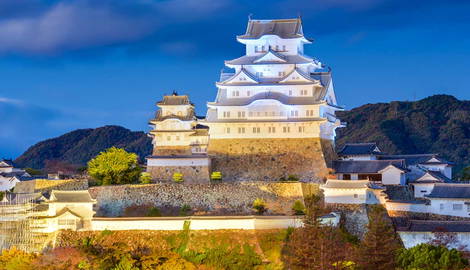
Medieval castles evolved as needs or technology changed. Normal castle construction consisted of thick stone walls, battlements, ample food storage for soldiers, and perhaps a moat or an internal spring. Builders constructed castles in various ways over time, creating many unique structures without the aid of blueprints. A Norman stone keep in Britain looks different from a concentric castle built with a moat. So, with explanations done, let’s check out where some famous castles are!
Edinburgh Castle: Scotland’s Most Famous Castle

Edinburgh Castle, sitting high atop the city bearing the same name, started life in 1130. Future kings would add pieces, like David’s Tower, built in 1444, featuring thick walls and arrow slits. The Castle served as the seat of Scottish kings and is a great piece of Scottish history. In 2023, 1.9 million people visited Edinburgh Castle.
Windsor Castle in England

Nestled in the county of Berkshire, Windsor Castle could be one of the world’s most famous structures. One undisputed fact: Windsor Castle is the oldest inhabited castle. Started by William the Conqueror in the 11th century, subsequent rulers made improvements. Windsor Castle started to change from a fortress to an official residence with Edward III circa 1350.
Though not a genuinely Gothic castle, Windsor contains many Gothic features. St George’s Chapel, built in 1348, has flying buttresses, pointed arches, and large stained-glass windows. The Round Tower, in the Castle’s center, was a central defensive point.
The British Royal Family uses Windsor Castle as a weekend residence. Other uses are when a citizen receives an award from the Royal Family.
Alhambra: Spain’s Most Famous Castle

This can only be Alhambra Castle in Granada (southern Spain). Situated on a hill, it’d be more accurate to describe Alhambra as a fortress complex. The Moors (Moslem inhabitants of Spain) built the Castle atop Roman ruins in the 12th century. After the Christian Reconquest in 1492, it became a royal place. Designated as a World Heritage Site, Alhambra is renowned for its Islamic architecture.
Among Alhambra’s features are reflecting pools, fountains, and channels. These embody paradise in Islamic culture—the Court of the Lions with a central fountain braced by a dozen marble lions. The ornate décor, featuring geometric patterns and calligraphy, adorns many of the rooms.
Unique historical Alhambra fact: Christopher Columbus got permission from Queen Isabella in the Hall of Ambassadors to sail west in search of India.
Germany’s Eltz Castle

Actually, Eltz Castle never faced being rebuilt, one of only two German castles among dozens. Any thoughts of castles invariably lead to Germany. With an estimated 25,000 structures, many of which are fortified, it’s hard to be different. Yet Eltz Castle, sitting on a hill on the Moselle River, does. Second, for over 850 years, the Castle has remained a family-owned residence.
Built in the 12th century, Eltz Castle is known for blending Gothic, Baroque, and Romanesque architecture. Boasting eight 35-meter-high towers and timber frames, this Castle makes for an unusual sight. Set amidst a natural preserve, visitors get a medieval castle’s full look with no modern structures around.
Japan’s Himeji Castle

Japan, with its iconic militaristic samurai heritage, is no stranger to castles. With 100 remaining from feudal times, Himeji Castle’s construction began in 1333. Due to the plaster-covered walls and its soaring roofs, Himeji is nicknamed “White Heron Castle.” Also, a World Heritage Site, the Castle has withstood war, earthquakes, bomb strikes, and fire.
Like many fortresses, Himeji Castle is a hilltop fort. Unlike European castles built of stone, timber framing provides the backbone. Thick, wooden walls, plastered in white paint, give Himeji its bright appearance. The base is stone like most Japanese castles.
Castle defenses are very intimidating to any attacker. Himeji’s defenses take on unusual parts, like a maze-like pathway to slow or confuse attackers. A more brutal defense is the stone drop windows or ishi-otoshi; defenders dropped rocks onto their besiegers’ heads.
Poland’s Malbork Castle

Malbork Castle started life as the Teutonic Knights’ headquarters in Malbork, Poland. These knights ruled parts of Europe for centuries. Red bricks were characteristic of their buildings. Construction began in 1274 with the final parts added by 1406. By then, Malbork Castle covered an impressive 44 acres or 143,591 square meters. The Teutonic Order lost the Castle in 1410. Over time and due to neglect, Malbork had fallen into disrepair by the 1940s. A thorough post-war two effort restored the Castle to its initial appearance. Today, it serves as a museum.









